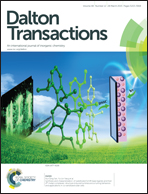Discrete and polymeric cobalt organophosphates: isolation of a 3-D cobalt phosphate framework exhibiting selective CO2 capture†
Abstract
Structurally diverse mononuclear, dinuclear, and tetranuclear cobalt organophosphates and a three-dimensional framework based on a D4R cobalt phosphate are reported. The role of auxiliary ligands in determining the nuclearity of the phosphate clusters has further been established. Reaction of cobalt acetate tetrahydrate with 2,6-di-iso-propylphenylphosphate (dippH2) in methanol or DMSO in the presence of ancillary N-donor ligands leads to the formation of mononuclear octahedral cobalt phosphate [Co(dippH)2(py)4] (1), dinuclear octahedral cobalt phosphates [Co(dipp)(NN)(MeOH)2]2·2MeOH (NN = bpy 2; phen 3), tetrahedral cobalt phosphates [Co(dipp)(L)2]2·2(MeOH) (L = imz 4; dmpz 5) and symmetric and asymmetric tetranuclear tetrahedral cobalt phosphates [Co(dipp)(2-apy)]4 (6) and [Co4(dipp)4(2-apy)3(DMSO)]·(DMSO)·(H2O) (7), in nearly quantitative yields. The use of a linear N-donor ditopic linker, 3,6-di(pyridin-4-yl)-1,2,4,5-tetrazine (dptz), as the ancillary ligand leads to the formation of a robust three dimensional, four-fold interpenetrated network based on the D4R platform, {[Co(dipp)(dptz)0.5]4}n (8), under ambient conditions. The new compounds have been characterized by analytical, thermo-analytical and spectroscopic techniques. Further, the molecular structures of compounds 1–8 have been established using single crystal X-ray diffraction studies. Compound 1 is a mononuclear complex in which the dippH ligands occupy trans-positions around the octahedral cobalt ion. The core structure of compounds 2–5, a Co2P2O4 ring, resembles the S4R (single-4-ring) SBU of zeolites, whereas the Co4P4O12 inorganic core found in compounds 6 and 7 resembles the D4R (double-4-ring) SBU. Cobalt organophosphate framework 8 shows significant CO2 adsorption at 273 K (7.73 wt% at 1 bar and 18.21 wt% at 15.5 bar) with high selectivity to CO2 uptake over N2 and H2 at 273 K. Magnetic studies of these symmetric complexes indicate the presence of weak antiferromagnetic interactions between the metal ions via the phosphate bridging moiety.



 Please wait while we load your content...
Please wait while we load your content...